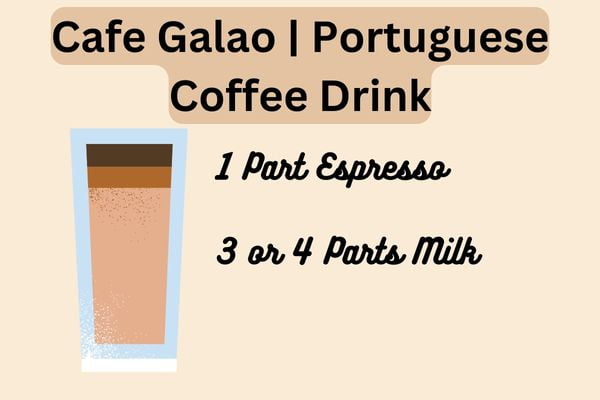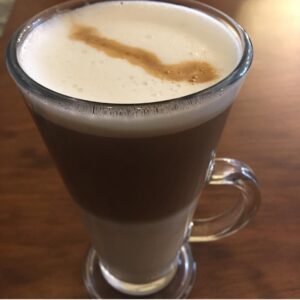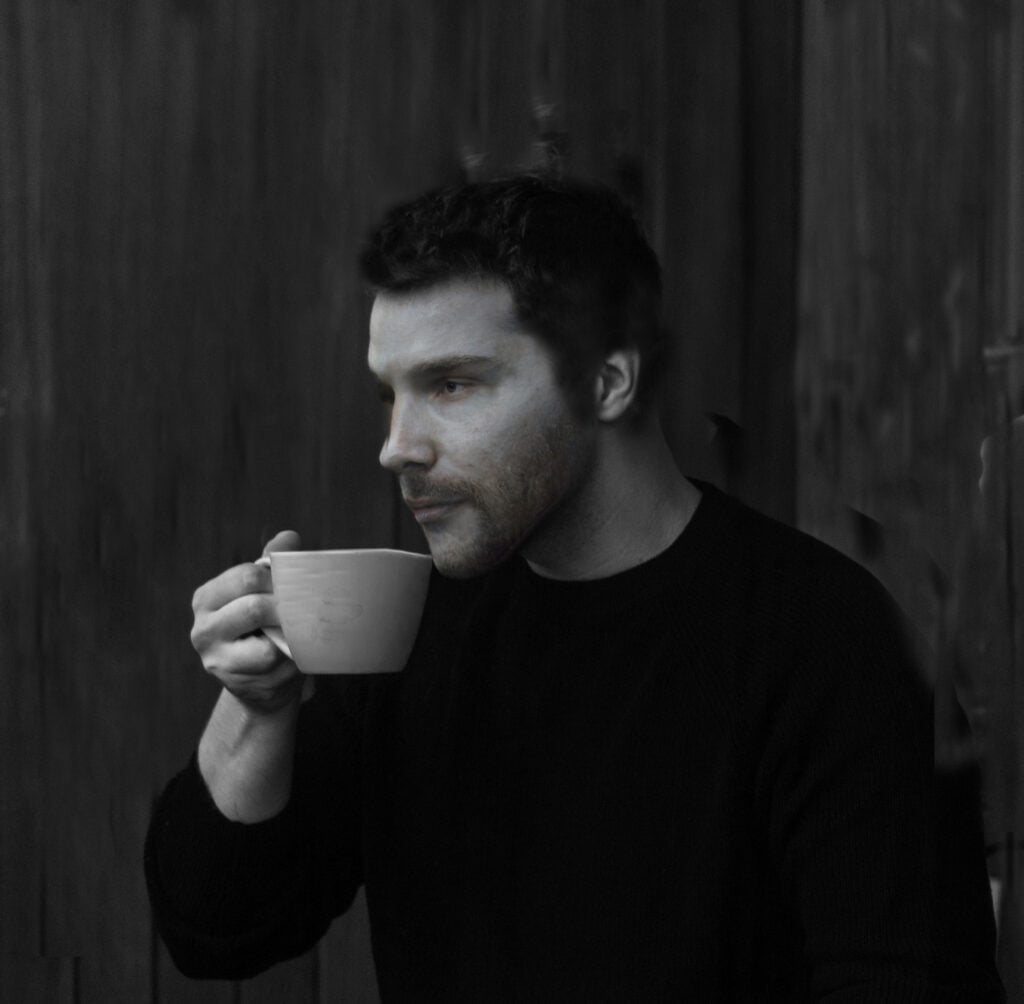Cafe Galao is a traditional coffee beverage originating from Portugal, which involves combining a shot of espresso with frothed milk. The term “Galao” is used to describe the tall glass in which the beverage is usually served.
Galao is a beloved coffee beverage in Portugal that offers a delectable blend of milk and coffee. With its rich, creamy, and subtly sweet taste, this popular drink is a hit among both locals and tourists and can be easily found at numerous coffee or pastry shops across Portugal.
In Portugal, Cafe Galao is often a breakfast beverage, but you can enjoy it anytime. It is a delicious and comforting coffee drink that will warm you up on a cold day.

In this article, I’ll explore the rich and creamy taste of this drink, and I’ll share with you how to prepare it in the comfort of your own home. Get ready to have warm and comforting flavors of Galão coffee!
How to make Cafe Galao
The preparation of Cafe Galao involves blending a shot of espresso with milk and then served in a tall glass. The ratio of espresso to milk in Cafe Galao is typically around 1:4 or 1:5 with 1 part Espresso and 4 or 5 parts milk.
What you need
- Espresso Machine
- Steaming Wand
- 14-18 grams of Coffee Grounds
- 10-12 oz Whole Milk
Step-by-Step Recipe:
1. Prepare a Double Espresso Shot: Start by grinding 14-18 grams of coffee beans to fine settings and pull a double shot of Espresso with the Espresso Machine.
2- Steam the milk: Pour freshly prepared Espresso shot and 10-12 oz cold milk into the steaming pitcher and steam them together. Keep the wand near the bottom of the pitcher and slowly raise it as the milk starts to foam. Stop frothing, Once the milk reaches a temperature of around 150-160°F.
3- Serve: Your Galao coffee is all set! Pour it carefully into a tall glass, using a spoon to keep the foam separate at first. Once poured, add the foamy milk on top and dust with cocoa powder.

Check a list 30 different Espresso based Coffee drink
What is the difference between a latte and a galao?
Cafe Galão is similar to a latte but has a higher proportion of milk to espresso, making it more sweet and creamy. This drink is popular in Portugal.
The main difference is Cafe Galao is prepared by steaming and blending the milk and espresso together in a pitcher. This unique method creates a smooth and consistent taste and texture throughout the entire drink. On the other hand, a latte is traditionally made by pouring steamed milk over the top of the espresso shots, resulting in a layered texture.
Another way that Galao Coffee and a latte are different is in how they are served. Cafe Galao is typically served in a tall glass, which shows off its frothy appearance. A latte, on the other hand, is usually served in wide mugs with elegant latte art on the top.

Other similar Portuguese Coffee drinks
In Portugal, coffee is a big deal. You can find a Pastelaria or coffee shop on almost every corner, making it a central part of everyday life. These places are always buzzing with customers, especially in the morning.
Portugal has a variety of coffee drinks to offer, each with its own unique twist. If you’re looking to immerse yourself in the local culture, it’s essential to know the most common types.
Um Café
“Um café” is a frequently used expression in Portuguese that translates to “a coffee” in English. This phrase typically refers to a small but potent shot of espresso, the same as Italian Espresso, which is often served in a demitasse cup.
It is typically served in a small glass with water, allowing drinkers to cleanse their palates between sips and fully savor the complex flavors of the coffee.
In Lisbon, you would ask for “uma bica” (bee-kah) whereas in Porto you would ask for “um cimbalino.” You can just ask for “um café” in either city, though, and people will know what you mean.
portugalist
And if you want a larger double espresso shot you can ask for Um café Duplo.

Meia de Leite
“Meia de leite” is another milky coffee beverage that can be found all across Portugal.
The difference between Galao and Meia De Leite is that it is made with half coffee and half milk while the Galao has a large proportion of milk.
Meia De Leite literally means “half milk,” as it’s made by combining equal parts of steamed milk and coffee, resulting in a strong coffee taste.
This drink is similar to Cafe Au Lait or Cafe Misto.

Café com Cheirinho
For an unforgettable coffee experience in Portugal, be sure to try “Café com Cheirinho.” This regional favorite translates to “coffee with a little scent,” and it’s not hard to see why.
This special drink is made by adding a small amount of Portuguese brandy called Aguardente to a shot of espresso, creating a unique and enticing aroma and flavor
Cafe Com Cheirino is similar to Italian Espresso Corretto but with a Portuguese touch.

Café descafeinado
If you want the taste of coffee but without the caffeine, “Café Descafeinado” is the drink for you.
Another tip for those who take their coffee temperature seriously, there is a hack in Portugal: you can request a “Chávena Quente” or hot cup, to keep your drink warm for a longer period.
Um Garoto
“Um Garoto” is a coffee drink that is popular in Portugal. It is made by combining espresso with foamed milk and is similar to a cappuccino.
Garoto means kid in Portuguese as this was the coffee kids drank before they were allowed to have a proper coffee.
misadventureswithandi
Um Café Mazagran
“Um café mazagran” is a refreshing coffee drink that originated in Algeria but is also popular in Portugal.
It is typically made with cold black coffee, lemon juice, and sugar, and served over ice in a tall glass. Some variations also include rum or a dash of brandy.
Final Thoughts
After reading this article, you can confidently walk into any Portuguese Pastelaria or coffee shop and order the perfect cup of coffee to suit your taste.
Whenever I visit Portugal, I always make sure to order a Cafe Galao, preferably with a fresh pastry on the side. It’s the perfect beverage to start my day or to enjoy during a relaxing afternoon break.
Have you had the chance to sip on a Café Galao yet? Share your thoughts below and spill the beans on your experience!
Read about other popular Espresso based drinks
Portuguese Galao Coffee Recipe
Equipment
- Espresso machine
- Milk Frother
Ingredients
- 14-16 grams Coffee Grounds Dark Roast Preferred
- 8-12 ounces Milk Whole Milk Preferred
- Sugar or Sweeteners According to taste
Instructions
- Prepare a double shot of Espresso using 14-18 grams of coffee grounds.
- Now pour both the milk and espresso shot into the steaming pitcher and steam them together.This will create a well blended and harmonious mixture
- Transfer the drink from the steaming pitcher to a tall glass by holding off the foam with a spoon and gently top the drink with the foam.




